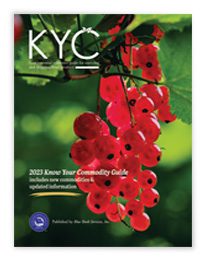Endive Market Summary


Image: Marta navarroP/Shutterstock.com
Endive Market Overview
Endive is a biennial plant and part of the Asteraceae or dandelion family. Originating in the Mediterranean region centuries ago, though some pinpoint Egypt as its true birthplace, endive varieties have been prized for their texture and flavor, as well as medicinal qualities. Related to chicory and radicchio, endive has two dissimilar pronunciations—‘n-dive’ or ‘on-deev’—demarcating varieties. Belgian endive (sometimes called French endive), curly endive, and escarole are covered in this profile. Most U.S. production of Belgian endive is in California, though the first stage of its growth can be cultivated in most regions. Escarole and curly endive are grown in several states seasonally, with California, Arizona, and Florida as leading suppliers.
Types & Varieties of Endive
Though the terms escarole, endive, and chicory are often used interchangeably, there are distinct differences in both appearance and flavor. The usual pronunciation, ‘n-dive’ refers to curly endive and escarole while ‘on-deev’ generally refers to the Belgian or white type of endive. Curly endive, also called frisée or curly chicory, is field-grown and has small, slender ‘frizzy’ or lacy-looking yellow-green leaves around a compact head, with a peppery flavor. Varieties include Frisan, Galia, Keystone, Marcant, President, Salad King, and Tosca. Escarole is also grown in the field and often called broad-leaf endive or Batavian endive; it has darker green, flat, smoother leaves around a loose yet balanced heart and can be less bitter than its siblings. Varieties include Broadleaf Batavian, Coral, Florida Deep Heart, Full Heart, Salanca, Sinco, and Twinkle. Belgian endive, also called witloof chicory, refers to the white or red crunchy oval-shaped shoots that grow out of stored chicory roots with a nutty somewhat mildly bitter taste. It is prized by chefs and gourmands as an elegant addition to meals and side dishes and is often referred to as ‘white gold’by connoisseurs. Types are classified by season with benefits related to its two-stage cultivation process: early season has a shorter growing cycle, mid- or ordinary varieties purportedly have better yields while late varieties are hardier and more tolerant of storage. A few varieties include Flash, Roelof, Totem, and Zoom.The Cultivation of Endive
Curly endive can be grown seasonally with mild sunshine and moderate temperatures. Fall harvests are ideal as too much sun or warmth can cause bolting and bitterness in the shaggy leaves. As it approaches maturity, curly endive is often covered to prevent sun from reaching the plants to maintain coloring, tenderness, and flavor. Belgian endive has a complex, labor-intensive growing process as it begins with field-grown chicory. Blue-flowered chicory seed is planted in loamy or mucky soils, grows leafy foliage over several months, then is dug up in the fall for its carrot-like taproot and crown. Delayed harvesting (after more than 150 days in the ground) may cause plants to bolt. The roots are cleaned and stored in dark, cool, humid conditions similar to mushrooms, until the temperature is raised and the bud is ‘forced’ to regrow in soil or a hydroponic solution. In about three weeks, new white shoots called chicons, tinged with red or pale yellow-green tips, emerge in an elongated torpedo shape. Once the tops are snapped or broken off, roots are discarded or repurposed as cattle feed. Exposure to light during the growing process can cause bitterness in the leaves. Escarole is much the opposite; it is a cool season crop and grows best with ample sun and consistent moisture in well-drained soil. Plastic mulch can help regulate soil temperatures, prevent weeds, and retain moisture (a lack of moisture can cause bitterness). Plants should have ample space, with about a foot between, as over-crowding (and high temperatures) can lead to bolting.Pests & Diseases Affecting Endive
Escarole and its lettuce siblings are vulnerable to a number of pests including harvester or fire ants, aphids, armyworms, beetles, bollworms, cabbage loopers, caterpillars, crickets, cutworms, grasshoppers, leafhoppers, leafminers, lygus (tarnished plant) bugs, slugs, snails, stink bugs, thrips, and whiteflies. Mosaic viruses infect plants, which then become reservoirs of the disease, stunting growth. Cucumber, lettuce, and turnip mosaic virus are similar in nature, though the latter is more prevalent in escarole. Ironically, turnip mosaic virus was inadvertently transferred to some escarole varieties while breeders were building resistance to downy mildew. Symptoms include slowed development, lack of coloring, tears and crimping in leaves, and eventually plant death. Beet western yellows virus has an impact in California, Arizona, and Florida. It causes a pronounced chlorosis of the outer leaves of lettuce and escarole. Other diseases of note include bacterial blight, bottom rot, damping off, downy or powdery mildew, fusarium, grey or white mold, soft rot, tip burn, wilt, and yellowing.
Storage & Packaging of Endive
Both Belgian endive and escarole should be cooled after harvest to 34 to 36°F with high relative humidity (95 to 100%). They are, however, susceptible to freezing injury if stored below 32°F for any period of time. Although a low producer of ethylene, exposure to higher levels can cause yellowing. References: New England Vegetable Management Guide, Oregon State University, Rutgers University, University of Arizona, University of Florida/IFAS Extension, University of Massachusetts Amherst, USDA.Grades & Good Arrival of Endive
There is only one grade for escarole, endive, or chicory: U.S. No. 1. Plants should have similar varietal characteristics with fresh, well-trimmed and fairly well blanched leaves, free from decay and damage. There should be no broken, bruised, spotted, or discolored leaves, or evidence of wilt, dirt, disease, or insects.Generally speaking, the percentage of defects shown on a timely government inspection certificate should not exceed the percentage of allowable defects, provided: (1) transportation conditions were normal; (2) the USDA or CFIA inspection was timely; and (3) the entire lot was inspected.
| U.S. Grade Standards | Days Since Shipment | % of Defects Allowed | Optimum Transit Temp. (°F) |
| 10-5-2 | 5 4 3 2 1 | 15-8-4 14-8-4 13-7-3 12-6-2 10-5-2 | 32° |


